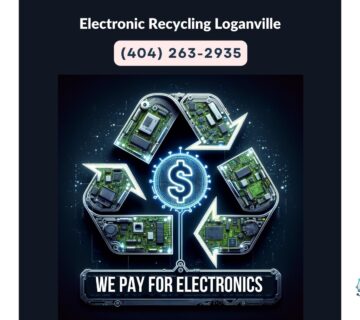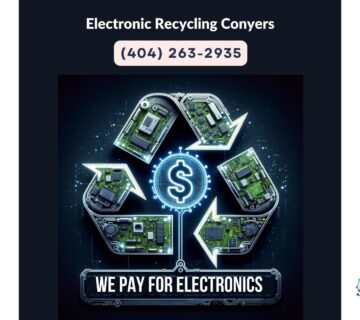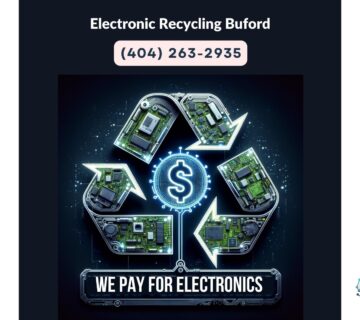Businesses rely heavily on servers, computers, and other IT equipment to run operations. But what happens when it’s time to upgrade or replace these assets? Far too often, old electronics end up in landfills, contributing to environmental problems. However, recycling servers, computers, printers and other IT equipment provides many benefits. This comprehensive guide explores the key advantages of recycling obsolete IT assets and how your organization can do it responsibly.
Reducing E-Waste from Servers and Computers
E-waste refers to discarded electronics like servers, computers, monitors and other IT equipment. With technology rapidly advancing and businesses constantly upgrading, e-waste is one of the fastest growing waste streams. Here are some key statistics:
- Globally, around 57.4 million tons of e-waste was generated in 2021, and only 17.4% was documented to be collected and recycled (UN).
- The number of installed servers worldwide is projected to reach 18.2 million in 2023, up from 13.6 million in 2018 (Statista).
- Data centers in the U.S. discarded about 2 million servers in 2019 and the number continues rising each year (EPA).
Much of this e-waste ends up in landfills, where hazardous materials like lead, mercury and cadmium can leach into soil and water. Improper recycling can also expose workers to toxic chemicals. Uncontrolled dumping abroad has created environmental disasters in some developing countries.
Properly recycling IT equipment like outdated servers, computers, printers and other electronics reduces the adverse impacts. E-waste also contains recoverable materials like aluminum, copper, gold and plastics that require massive resources to mine and manufacture. Recycling conserves natural resources and energy.
Recovering Valuable Components and Raw Materials
Servers, computers and other IT hardware contain components that can be refurbished and reused, such as memory, processors, expansion cards, hard drives and power supplies. Refurbishing and reselling functional equipment is an environmentally and economically sound alternative to scrapping it.
Servers and computers also contain precious metals and other raw materials that can be recovered through recycling:
- Gold – used in circuit boards and components like processors. There can be over $300 worth of gold in a standard server (CUI).
- Aluminum – used for chassis and housings. Servers contain around 10% aluminum by weight (SAMR).
- Copper – used in cables, wires and motor windings. Copper makes up around 6% of a server by weight (SAMR).
- Plastics – used for housings, structural parts and insulation. Recycling plastics reduces reliance on oil and gas.
Proper recycling recovers these valuable materials through shredding, separating, smelting and refining processes. The metals can be sold to manufacturers to make new products. Reclaiming raw materials ultimately requires less energy than mining and manufacturing them from scratch.
Protecting Data Security and Privacy
Data security is a top priority for any organization. Simply tossing old servers or drives into the trash can expose confidential data. Media sanitization is an essential first step before retiring IT assets. This involves completely wiping data to ensure no residual information remains that could be recovered.
Recycling providers use technologies like degaussing and disk shredding to destroy data. Degaussing applies powerful magnetic fields to disrupt and erase data stored on tapes, hard drives and other media. Disk shredding physically destroys disks by crushing, cutting or disintegrating them into small particles.
It’s critical to work only with e-recycling companies that follow best practices for sanitizing data and securely handling equipment. Industry-accepted standards like NAID AAA certification validate that vendors meet rigorous security controls. Using a vetted recycler protects your sensitive data and intellectual property while allowing hardware to be sustainably reused or salvaged.
Compliance With Environmental Regulations
Improperly disposing of e-waste contradicts most organizations’ sustainability commitments. It also risks violating environmental regulations at local, state and federal levels. Key laws include:
- Resource Conservation and Recovery Act (RCRA) – Requires safe handling and disposal of hazardous e-waste and prohibits dumping.
- basel Convention – Restricts transfer of hazardous waste between countries. Requires consent before exporting e-waste.
- EU Waste Electrical and Electronic Equipment (WEEE) Directive – Sets e-waste collection, recycling and recovery targets for EU members.
- State Laws – States like California, Indiana, Maryland, Texas and others have e-waste recycling laws governing disposal of electronics.
These regulations typically prohibit landfilling or incinerating e-waste. Fines and penalties can result from unlawful dumping. Working with a qualified e-recycler helps maintain compliance and environmental stewardship. Certifications like R2 and e-Stewards ensure vendors adhere to regulatory obligations.
Lowering Disposal Costs
Retiring old electronics that have reached end-of-life in an environmentally responsible manner does come at a cost for proper recycling and data destruction. However, the costs incurred are likely far lower than fees and risks associated with non-compliant disposal methods.
Dumping e-waste in landfills seems attractively cheap up front. But landfills charge per ton to accept waste. Servers and IT equipment are bulky and heavy, quickly adding up in disposal fees. Older CRT monitors also contain leaded glass requiring special hazardous waste landfills charging higher rates.
Fines for violating anti-dumping laws can easily exceed tens of thousands of dollars per incident. The reputational damage and liability associated with data breaches from improper discarding can cost even more.
Utilizing efficient e-recycling programs reduces volumes going to expensive landfills. Recycling and reusing equipment also qualifies businesses for tax deductions in many cases. Overall, the modest upfront investment in compliant e-recycling lowers total cost far more than attempted shortcuts around proper disposal.
Doing What’s Right for the Environment
At the end of the day, responsibly recycling aging IT equipment rather than dumping it irresponsibly is simply the right thing to do for the environment. Even with the best intentions, it can be tempting for overtaxed IT departments to take shortcuts in securely and sustainably retiring old hardware.
However, the negative impacts of e-waste on human health and the environment are well documented. Recycling helps alleviate the damages associated with mining and manufacturing by reclaiming materials already in circulation.
Choosing recycling over waste also sets an example and builds culture around sustainability. It signals to staff and stakeholders what your organization’s values are. Leading by example encourages sustainable behaviors beyond the workplace as well.
Best Practices for Recycling IT Equipment
Here are some key best practices for sustainably and securely disposing of servers, computers, printers and other obsolete IT hardware:
Audit Equipment and Create a Retirement Plan
- Maintain detailed asset inventories of all IT equipment including purchase dates, specifications and conditions.
- Identify systems and components that are obsolete, defective or at end-of-life to be retired.
- Develop a retirement plan and calendar for orderly phase-out of identified assets.
Sanitize Data and Remove from Service
- Follow accepted media sanitization practices to securely erase data from disks, drives and other storage media.
- Physically remove retired equipment from production environments like server rooms and data centers.
Choose a Qualified Recycling Partner
- Research and validate recyclers’ qualifications, certifications, security controls and downstream processes.
- Prioritize NAID AAA certified vendors adhering to standards like R2 or e-Stewards.
- Audit facilities and recycling practices through site visits or documentation reviews.
Safely Pack and Transport Equipment
- Sanitize equipment and remove batteries, accessories and removable media before packing.
- Protect drives and sensitive components from impacts that could damage data.
- Palletize and strap down equipment securely to prevent shifting during transport.
Maintain Chain of Custody Documentation
- Label each pallet or batch of retired equipment with a tracking number.
- Obtain chain of custody forms detailing the transfer, transportation and receipt.
- Require recyclers to report back serialization on destroyed drives and components.
Review Compliance Reports and Certificates
- Review documentation provided by recyclers confirming sanitization, materials recovery and disposition.
- Maintain audit trails demonstrating compliance and your due diligence.
- Ensure you receive any regulatory recycling reports or filings required.
By approaching IT asset disposition systematically using best practices, your organization can keep data secure, maximize recoverable value, reduce costs and responsibly retire hardware. This lightens environmental footprints without compromising security or compliance.
Frequently Asked Questions About Server and IT Recycling
Retiring servers, computers and other business technology can generate many questions. Here are answers to some of the most common FAQs around recycling IT assets:
Does our organization need to recycle obsolete IT hardware?
In most cases, yes. Leading corporations now view responsible e-waste recycling as mandatory according to survey data. Strict regulations also prohibit unlawful dumping which can generate substantial fines and penalties. Beyond compliance, recycling is the environmentally conscious choice.
What types of hazards are associated with e-waste in landfills?
A: E-waste contains heavy metals like lead and mercury plus toxic chemicals that can leach out of landfills. These contaminants can pollute groundwater and soil, adversely impacting human health. Lead is especially hazardous to children.
Is it bad to ship e-waste abroad to developing countries?
Exporting e-waste to developing countries is restricted under international laws like the Basel Convention. However, illegal shipments still occur, leading to environmental justice issues from unsafe recycling. Ethical recycling keeps e-waste closer to origin.
Can we simply donate old equipment instead of recycling?
Donating functional electronics for continued use is better than disposal. However, charities can become overwhelmed by obsolete technology donations. Also ensure sensitive data is fully wiped before donating any device.
Do we have to pay an e-recycling company to take our old equipment?
In most cases, yes. However, costs are minimal compared to non-compliant disposal. Some e-recyclers may provide free collection for equipment containing valuable recoverable commodities. But responsible recycling does require investment.
What certifications should we look for in a recycler?
NAID AAA certification validates data security controls are in place. E-Stewards and R2 certified recyclers adhere to stringent standards for environmental practices and worker protections too. These help identify responsible recyclers.
Can we be held liable if data is exposed after equipment disposal?
Yes. Organizations have faced lawsuits, fines and reputation damage when recycled assets containing customer data were not fully sanitized. Using accredited recyclers mitigates risk.
Where do the recovered materials from recycled electronics go?
Materials like plastics and metals are sold as commodities and used in new products. For example, copper and tin can end up in cars or building construction. Gold may be sold to component manufacturers.
Is landfilling servers considered hazardous waste disposal?
Often yes. Servers contain heavy metals, batteries, oils and other potential hazardous waste. Special permits and landfills are required for disposal. Recycling is far more responsible.
Properly retiring IT assets keeps hardware from harming the environment while allowing businesses to upgrade efficiently. Follow best practices to maximize benefits and mitigate all risks. With the right partner, securely recycling IT equipment enables continual technology innovation.
Why Server and IT Recycling Matters
Upgrading data centers and offices with shiny new servers, computers and devices is exciting. But properly handling obsolete electronics being replaced is equally important. Recycling aging IT equipment provides many advantages over irresponsible disposal for businesses and the planet.
In summary, here are the key takeaways on why server and IT asset recycling matters:
- Reduces dangerous e-waste accumulation in landfills and developing countries
- Recovers valuable components and precious metals for reuse
- Protects sensitive data and intellectual property from exposure
- Maintains regulatory compliance and avoids non-compliance penalties
- Cuts costs over landfilling and allows beneficial tax deductions
- Sets an example for environmentally and socially responsible behavior
With prudent planning, server and computer recycling can proceed smoothly each technology refresh cycle. Take the time to audit aging assets, securely wipe data, and partner with a qualified recycler. The modest investments pay dividends across the board over the lifecycle of the equipment. And they benefit the environment long after devices reach end-of-life.
What will your organization do today to keep old electronics out of landfills? Proper IT asset disposition takes planning and commitment. But the advantages make server recycling well worth the effort. Your business will lower IT costs, drive innovation and demonstrate environmental leadership all while protecting data and resources for the future.




